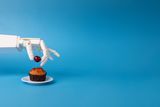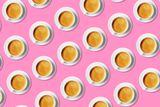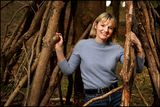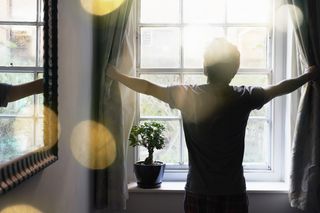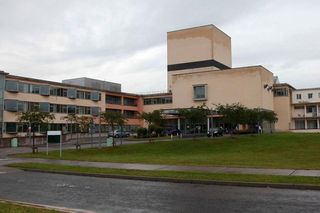Twenty years a-growing: a snapshot of Ireland in 1994
Having found a snapshot of Ireland 1994 in a 20-year-old copy of 'National Geographic', Will Hanafin went on a quest to find the people featured in it. Two decades on, he found stories of ups and downs, achievement and emigration, such as the little kids who proudly greeted President Robinson but who are now scattered across the globe. We've gone from payphones to iPhones and from economic boom to bust. But don't worry, we still have Fungie the dolphin to raise a smile
My mother-in-law is a big fan of National Geographic magazine and has more back copies in the house than you'd find in an overstocked medical-centre waiting room. I recently found an old edition that featured Ireland on the cover, which was published in September 1994 - exactly 20 years ago. For once, it didn't contain the hackneyed images of donkeys, thatched cottages and remote islands beloved of National Geographic writers doing features on Ireland. There were photos of child beggars on O'Connell Bridge, U2 fans at a concert, President Robinson greeting school kids on Inishbofin, and youngsters with a pony in Clondalkin. Peace groups in Belfast, Fungie the dolphin and blue-painted Macnas performers made an appearance, too. It also contained the prophetic enough headline, "Ireland on fast-forward". The journalist, Richard Conniff, wrote about drug abuse and needle attacks, the demise of the Catholic Church and he even noticed the rise of turbo sunbeds back in 1994.
The last 20 years have been tumultuous for Ireland with our great economic boom, followed by the crushing recession that we are still suffering the effects of. Fast-forwarding to 2014, we now have enormous debt, high unemployment, and emigration has returned with a vengeance.
Twenty years ago, we made do with A/B payphones, now we're addicted to iPhones. Instead of Enda and Joan, Albert and Dick were in charge. We participated in soccer World Cups back then, instead of being spectators. Sectarian killings were still rife in the North, but now Gerry Adams is best known for tweeting about his teddy bear. We were still winning Eurovisions and coming up with genius ideas like Riverdance, instead of crashing and burning before the finals this year.
To quickly reel in 1994: it was the year of OJ Simpson's arrest; Braveheart was filmed here; it was the year of the Fr Brendan Smyth controversy and subsequent collapse of the Government, and a time when Offaly could win All Irelands.
Try as I might, I couldn't get that 1994 National Geographic magazine out of my head. All those people who were photographed and interviewed - where were they now? How did they get on in the intervening 20 years, and what did National Geographic writer Richard Conniff and photographer Sam Abell make of their Irish experience? This article is about how I tracked down the people from that September 1994 National Geographic.
I found most of the people who were featured in the article, mainly through Twitter; that most 2014 of things, a micro-blogging social-media site. Twenty years ago, random thoughts were kept to ourselves. Now, with Twitter, you can inflict them on the world. Tracking down the author and the photographer proved more challenging. I eventually found writer Richard Conniff in South Africa. He was writing a National Geographic feature on leopards and shooing vervet monkeys away from his coffee while I interviewed him. I made contact with photographer Sam Abell on holiday in Nova Scotia. Sam has vivid memories of the shoot, carried out in 1993 and 1994, mainly for the wrong reasons. "The reason is that the first week I was in Ireland, I had been mugged and robbed in St Stephen's Green in Dublin by two skinheads who wanted my camera. Talk about a double-digit downer at the beginning of an assignment!"
After that bruising welcome to Dublin, Sam ended up bumping into Bono, as you do. "I met Bono by chance in a small Italian restaurant in downtown Dublin. He knew NG and liked the magazine. He also seemed amused that I'd been mugged and robbed in St Stephen's Green. 'You was mooged!' he said with relish, and asked for details. When I got to the part about being kicked in the back when I was already down on the ground, he said, 'They respected you!' That thought hadn't occurred to me, so I asked what he meant. 'They thought you might get up and chase them. Kicking you kept you down'."
Sensing his opportunity, Sam asked to hang out with Bono and photograph him off-stage. Bono enthusiastically agreed and said: "Line it all up with Paul here," gesturing to the man with him.
"Bono left; Paul took over and squelched everything Bono had agreed to. Later, I came to understand that Paul was the bad cop. What Paul got me was an ordinary and limited photo pass to the concert. I was one of about 50 photographers held in a holding pen prior to the concert. We were only to take photos for the first three songs of the concert," says Sam.
What Sam got access to was the Zoo TV gig at the RDS in 1993. When the three songs were finished, he decided to turn his camera on the crowd. "So I turned my back on the stage and concentrated my seeing on the rapt and densely packed crowd. After all, my story was about Ireland, not Bono," he says.
The resulting image is an evocative crowd shot of the 90s U2 fans, with their step haircuts and perms, large, wire-framed specs and baggy T-shirts, staring at the band. Some have marker-drawn tattoos on their arms, and even their foreheads, with the words 'Larry', 'Bono' and 'Edge' written on them. I managed to track down some of the fans, including the Keane brothers, Derek and Morgan, from Skerries, who were 11 and 14 at the time. "Morgan's T-shirt is soaking in that picture. Believe it or not, Naomi Campbell saw that he was soaking with water and gave him a dry T-shirt. She was engaged to Adam Clayton. Morgan also managed to catch a harmonica from Bono when he threw it down after Desire," Derek says.
"I remember that National Geographic magazine. It was unbelievable, because my father got the magazine for years. We framed the pictures afterwards. We still live in Skerries, but I did live in Oz for two years. Bono has a long connection with Skerries. He was friends with the priest Fr Jack Heaslip from Skerries, and my brother, Morgan, and older brother, Barry, are really massive fans of U2. They have been to loads of their concerts since, all over the world," says Derek. The eldest brother Barry (42) is now in the car-sales business, Morgan (32) is a model, and Derek (35) is an electrician.
Another U2 fan in that crowd picture was David Mullen (39), who was wearing his brand-new black-and-white U2 baseball cap, standing in the centre of the shot. "I was 18," Mullen says now, "and had just finished the Leaving Cert in Ballina, and 24 of us went up to Dublin from Mayo for the U2 gig. We booked into a grotty hostel, and I remember waking up on the Saturday morning and staring out at the Poolbeg chimneys, which we recognised from their videos. I was a massive fan then, and remember travelling to Dublin to get tickets with my mate, Kevin. We got the last ones at a yellow-fronted shop in Temple Bar."
"I was one of those people besotted by U2, and the Zoo TV tour re-imagined the whole visual experience. We were bang-smack in the front as we'd queued from early in the day and got armbands," David says.
His devotion to U2 has dimmed over the years. "I've seen them every time in Ireland and I'm one of those guys who always staunchly defends Bono. I will definitely go see them if they play again, but the last couple of gigs disappointed me. The second-last time they played the same song twice and it's now all about the show rather than the music."
What did David do with his life after the Leaving Cert in 1994?
"I went to college and then I went to work. I was in a couple of relationships and now I'm due my first baby in December with my partner, Nicky. I work in project management and am self-employed."
David also tells me what he thinks of the changes in Ireland over 20 years. "In Ireland, so much has changed and so little has changed. It's good that we've become more multi-cultural, but we are a lot less forgiving. It's certainly a more interesting place to live in."
And what about his fetching U2 baseball hat? "I bought it at the gig from the merchandising people. I don't still have it. I've had to have a clear-out for the baby and a lot of my old stuff has been recycled!"
Sam Abell had to stop taking photos after the three songs and had to hand his camera into a lock-up. But his wife was in the stands with another camera and managed to get the band shot that was used in a two-page fold-over photograph in the mag.
The photographer's favourite photo of the entire shoot was Fungie the Dingle dolphin leaping out of the water, while a little terrier dog looks at him from a boat.
"I use the images from that Fungie experience to teach the principle of 'compose and wait' - a core principle of how I make photographs," Sam says.
"In this instance, I had been told that the dog in the photo had 'a relationship' with Fungi. For 20 minutes nothing happened, despite the barking of the dog. Then Fungie shot straight up out of the water. At the top of his leap he looked down, saw the dog, and chirped. Pandemonium. For the next spell of time we cruised the harbour with the leaping, chirping Fungi as our companion."
Still, Abell wasn't sure he would be able to take a good shot: "I chased the two highly animated animals from one side of the boat to the other, despite knowing it was a futile approach to making a photograph. I knew from the Galapagos that when you see a dolphin leap, the moment is already past, photographically."
Instead of chasing the dolphin and dog around the boat, he composed a scene with no dolphin. "It's a three-layer composition: layer one, the side of the boat with the dog; layer two, the sea; layer three, the coastal landscape. All that was missing was Fungie."
"By and by, the dolphin appeared alongside the boat. The captain shouted, 'Here comes Fungie!' I sensed his imminent arrival and clicked the shutter when he shot into view, occupying the place in the composition that was vacant. There was no way to know I got it. It was the era of film, and I worked on faith. The end of the story is that the picture worked. It is considered a classic of the 'compose and wait' school of photography," Sam says.
The only Irish public figures featured in the National Geographic article still really active are Bono, Mary Robinson, and Fungie. It's remarkable that when the photo was taken in 1994, Fungie had already been in Dingle for 11 years.
Jimmy Flannery Jr is chairman of Dingle Dolphin Tours, has been a captain since he was 17, and has taken people out to Fungie for 22 years. Just what has Fungie been up to since 1994, and has he ever got sick of it all? "He has never taken a break. He may go away feeding for an hour or two, but that's it. There have been other schools of dolphins arrived over the years, but he's not interested. The only reason that Fungie stays in Dingle is because he wants to," says Jimmy.
Even though scientists estimate that Fungie is now pushing 40, Jimmy doesn't see any evidence of middle age setting in. "He is not one bit slower. He is as lively as he ever was."
Jimmy has been doing the trips for so long, he feels that he's in tune with Fungie's moods. "When you spend time with Fungie, you get to know him. During the first five minutes of the trip I know whether his form is good or bad."
The skipper also feels Fungie has an uncanny power. "Fungie has this strength. He definitely knows what you're thinking. I always worry about him. He is part of the family. If I'm having a bad day, I take a small boat out and chat to him," Jimmy added.
Since 1994, Fungie has faced some challenges that did put him in danger. "The harbour was dredged and we coaxed him out a bit away from it. Then, a few years ago, a Spanish boat hit a rock coming into the harbour and breached its diesel tanks. Ten thousand litres of diesel were spilt. Again we coaxed him away from there by getting him to follow the boats."
In the 20 years since he was snapped by Sam, many celebs have been anxious to see the world's most famous bottlenose dolphin. Jimmy's favourite was Pierce Brosnan, who swam with Fungie 19 years ago. Recent celebrity Fungie fans have included actress Laura Dern, and actor James Nesbitt.
Jimmy would love to know what Fungie makes of it all. "He has opened up the world of the ocean to thousands of people. A lot of people would never have gone out in the water if it wasn't for Fungie. I often wonder does Fungie realise what he has created in Dingle. There are 18 people in full-time employment and enormous tourism spin-offs."
Two little girls getting their First Holy Communion outside St Mary's Church in Dingle made another arresting image for the article. The girl on the right is Angela Ryan. She still lives in Dingle, is married to Darren and has one little girl named Chloe, and a stepson, Killian.
"The other girl's name was Michelle," Angela says. "She was in my class for a little while, but her family were travelling around because of her dad's job, so she left a few months after the Communion. I remember the day vaguely. My aunt made the dress and the Communion was a really big deal. The same as all other Communions in Dingle! There are five of us in the family, and I have three sisters and one brother."
"I stayed in Dingle. I went to college for a while, studying Design Communication in CIT. College wasn't for me, and then I met Darren and got married at 23. I have a 10-year-old stepson, Killian, and daughter, Chloe."
Chloe has cystic fibrosis and the family are passionately involved in fund-raising and awareness. Darren is to climb Mount Kilimanjaro next January to raise funds for Cystic Fibrosis Ireland.
"We have a great support system in the Butterfly Unit in Limerick Regional Hospital," Angela says. "We go there every two to three months. It was diagnosed in Limerick through the heel-prick test when she was three weeks old."
When Chloe is six, she will be taking a ground-breaking drug to treat CF called Kalydeco. "It's the closest thing to a cure that they have," Angela says, "and works on lung function. She can only take it because she has CF with the gene mutation G551D. Kalydeco works on that."
Kalydeco is a first of its kind in the world, as it works to prevent deterioration and keeps people with cystic fibrosis at their current level of lung function. Since its sanctioning by the HSE last year, approximately 120 patients will be suitable for Kalydeco treatment.
The reporter of the piece is renowned writer Richard Conniff, who spent eight weeks here. A lasting memory was his encounter with Loyalist terror groups in Northern Ireland. "I met the Protestant paramilitary leaders at a Loyalist town outside Belfast. I met these guys - they were terrorists - but it was an incongruous meeting place. We met over an ice-cream parlour called Melting Moments. It was a dark room and we had conversations about the whole nature of the Troubles. Steven Spielberg's movie Schindler's List was just out. The leaders of the paramilitary movement then had intense conversations with me, comparing their situations to the Jews in Germany. It stuck with me because it was such a twisted interpretation of that movie."
What does Richard think was different about Ireland back in 1994? "I did have a laptop, but I didn't have internet as far as I know. People didn't spend their days with noses in iPhones and they talked a lot more. Somebody walking into a Dublin pub and popping out an iPhone would have been greeted with such ridicule back then. Back then, drunk driving was much more tolerated. The idea of going out and having five pints and then driving home was seen as fine, and tobacco was everywhere."
The American writer is of Irish descent and visited annually from the 1970s, but saw things he didn't like in 1994, and hasn't been back since. "After 1994, I dropped it. I was distracted by other things, but also I wasn't enthusiastic about the way Ireland was going. In Ireland, I liked the older way that was orientated to the beauty of language, and wasn't so much into the modern conveniences. People started to believe in themselves, but the vision that replaced it was a materialistic vision," he says.
Because Ireland faced a host of controversial social issues in 1994, from abortion, contraceptives and child sexual abuse, Richard found himself in trouble with his National Geographic editors.
"They were issues which were pretty current everywhere in the world like abortion, the Catholic Church and condoms. National Geographic had never published the word 'condom' until that time, and I also had a fight about the end of the story. It was a bit of a downer, and the editor didn't want readers to be left with a pessimistic ending and I did."
Richard also got his wires crossed more than once as he tried to engage with Dublin's chattering classes. "The US ambassador Jean Kennedy Smith had just arrived, and I had her to dinner at the house I was renting in Dublin. David Norris was there and some activists, and they were talking about problems in East Timor. I thought East Timor was a suburb of Dublin! We were clueless."
The longest-lasting legacy for Richard about being in Ireland was a certain band that wouldn't go away afterwards. "My children, on that trip, became great fans of The Saw Doctors. I had to listen to The Saw Doctors for years afterwards," he says.
One of the most poignant pictures in the article is President Robinson greeting the schoolchildren of Inishbofin. "We were in the West of Ireland and committed to attend the music festival on Inishbofin, when I read of President Robinson's plan to also be there. That doubled my interest. At the time, she had a significant profile and presented a most modern face of Ireland to the world. She was appealing," says Sam Abell.
Fiona O'Mhuiri is one of the proud mums in the picture greeting the President. "The reason she was here that time was to officially open our Arts Festival, which, because she was the first female President and we had an all-ladies arts committee, we felt it was fitting to ask her to do the honours! There's Oisin Lavelle, Regina King, me, Vivienne Lavelle, Orla Day and the teacher, Rachelle, at the back. At the front is Niamh Fox, Elaine Day, Aoife King, Jason Prendergast shaking Mary Robinson's hand, and her husband, Nicholas, standing behind her, then Robbie Murphy and Philip Coyne."
Twenty years on, emigration has hit that little class very hard. "Oisin is in New Zealand, self-employed and doing nicely. David and Vivienne Lavelle, his two paternal first cousins, are also abroad. David is living in Sydney, also self-employed and married with a baby girl. Vivienne trained here as a sports physio and lives in the UK. Jason Prendergast is living in the USA, married and self-employed. Robert Murphy is living and teaching in Bangkok. Aoife King is a language translator and living in Italy," says Fiona.
The Ireland trip has had a profound effect on photographer Sam and his wife. "Myself and my wife have happily travelled together for National Geographic for 25 years and she longs to return to Ireland, as that assignment was her favourite. I'm not so sure. I got mugged and robbed the first week we were there.
"And the photographs did not come easily. There was an elusive Irish essence I was always trying to evoke - part beauty, part humanity, part cultural history. Because I'm Irish the assignment had extra importance for me. Personally and photographically, I wanted to live up to the ineffable meaning of the word Ireland. Of course, I could not," says Sam.
Join the Irish Independent WhatsApp channel
Stay up to date with all the latest news




